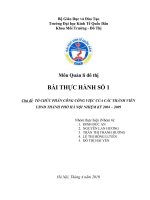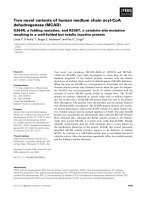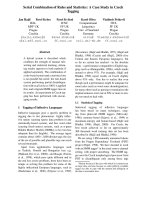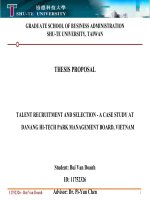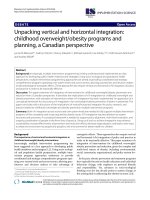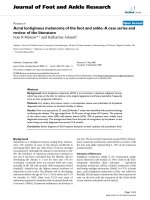Integration between radical innovation and incremental innovation to expedite supply chain performance through collaboration and open-innovation: A case study of Indonesian logistic
Bạn đang xem bản rút gọn của tài liệu. Xem và tải ngay bản đầy đủ của tài liệu tại đây (894.53 KB, 12 trang )
Uncertain Supply Chain Management 7 (2019) 191–202
Contents lists available at GrowingScience
Uncertain Supply Chain Management
homepage: www.GrowingScience.com/uscm
Integration between radical innovation and incremental innovation to expedite supply chain
performance through collaboration and open-innovation: A case study of Indonesian logistic companies
Ernaa*, Surachmana, Sunaryoa and Atim Djajulia
a
Post Graduate Doctoral Program in Management Science Economics and Business Faculty, Brawijaya University, Indonesia
CHRONICLE
Article history:
Received September 9, 2018
Accepted October 12 2018
Available online
October 12 2018
Keywords:
Radical innovation
Incremental innovation
Open-innovation
Collaboration
Supply chain
Logistic
ABSTRACT
During the past few decades, logistic industry has grown rapidly worldwide, however, the
performance of Indonesian logistic industry is decreasing due to various supply chain issues.
Logistic companies are suffering with low performance which has negative consequence on
gross domestic product (GDP). To address this issue, the primary objective of the current study
is to investigate the role of innovation in supply chain management. By using the cross-sectional
research design, 300 questionnaires were distributed among the employees of logistic companies.
All the questionnaires were distributed by using area cluster sampling. PLS-SEM was preferred
to achieve the objectives of the current study. Findings of the study have revealed that
collaboration with supplier, customers and external partners had significant positive relationship
with radical and incremental innovation. Moreover, radical and incremental innovation
maintained significant positive relationship with open-innovation performance. An increase in
open-innovation increases the supply chain performance among Indonesian logistic companies.
Therefore, logistic companies must focus on innovation to boost their performance. This study
contributed in the body of literature by examining the important role of radical and incremental
innovation in supply chain performance.
© 2019 by the authors; licensee Growing Science, Canada
1. Introduction
During the past few decades, logistic industry has grown rapidly worldwide (Hameed et al., 2018). This
industry has significant effect on the economic development of every country (Lan & Zhong, 2018).
An increase or decrease in logistic industry performance plays major role in gross-domestic product
(GDP). Therefore, to boost economy, logistic and supply chain industry has important contribution.
However, the performance of Indonesia logistics industry is decreasing day by day. According to the
report of World Bank in 2016, the Indonesian logistic industry decreased ranking up to 63 as compared
to the Malaysia, Thailand and Singapore. Indonesian logistic industry has low performance as
compared to Malaysia, Thailand and Singapore. Decreases in performance has negative effect on grossdomestic product (GDP) which shows negative effect on overall economy of Indonesia.
* Corresponding author
E-mail address: (Erna)
© 2019 by the authors; licensee Growing Science, Canada
doi: 10.5267/j.uscm.2018.10.006
192
Logistic performance index released by World Bank in 2016, shown in Fig. 1, demonstrates that
Singapore is at top in transport related logistic infrastructure following by the South Africa, Malaysia,
China, Thailand, Brazil, Mexico, India, Philippines and Vietnam. However, Indonesian transport
related logistic infrastructure facing worse condition as compared to all these countries. The present
worse conditions of Indonesian logistics are based on various issues such as supply chain issue.
Moreover, Fig. 2 indicates tax revenue percentage of gross-domestic product (GDP) from logistics. It
is evident that in tax revenues, Indonesian logistic is also facing issues due to which it has vulnerable
conditions as compared with the other countries. Therefore, logistic sector must insure better supply
chain practices.
Logistic Performance Index
Tex Revenue as % of GDP
4.5
4
3.5
3
2.5
2
1.5
1
0.5
0
India
Indonesia
Philippines
Singapore
Brazil
Korea
OECD
Malaysia
Indonesia
Vietnam
Philippines
India
Mexico
Brazil
China
Thailand
Malaysia
South Africa
Singapore
Thailand
Fig. 1. Logistic Performance Index (Quality of trade and transport
related infrastructure) Source: World Bank, World Development
Indicators (2016)
Turkey
South Africa
0
10
20
30
Fig. 2. Logistic Tax Revenues Source: World Bank, World Development
Indicators
Numerous research studies emphasised on the logistic from various views (Anselmsson, 2006; Hsu,
2006; Maurice, 2013; Enríquez & Adame, 2014; Purnama, 2014; Chielotam, 2015; Castorena et al.,
2016; Hu et al., 2016; Albasu & Nyameh, 2017; Cichosz et al., 2017; Mowlaei, 2017; Kucukkocaoglu
& Bozkurt, 2018; Maldonado-Guzman et al., 2018; Liu et al., 2018), however, in rare cases any research
study properly documented the logistic supply chain performance of Indonesian logistic companies. In
rare cases any study carried out a note of various threatening issues as well as performance of
Indonesian logistic industry. Therefore, this research study is one of the attempts to fill this research
gap by investigating the supply chain performance in Indonesia. This research study provided the
research framework to enhance supply chain performance and to increase the contribution of
Indonesian logistic companies in gross-domestic product (GDP).
Therefore, these issues can be resolved through various innovative strategies. Innovation as the
expansion and implementation of various creative ideas for advancing as well as evolving the mission
of an organization ( Khan et al., 2018; Santhi & Gurunathan, 2014; Anyanwu, et al., 2016; Mosbah et
al., 2017; Maroofi et al., 2017; Jones & Mwakipsile, 2017; Malarvizhi et al., 2018, Le et.al. 2018;
Rubin & Abramson, 2018). Innervational activities enhance the performance by taking competitive
advantage. Through innovation activities, logistic companies can develop new strategies for supply
chain management after collaborating with customers, suppliers and partners.
Innovations are in various types, however, in the current study two major innovation types, namely;
radical innovation and incremental innovation are selected. Both radical and incremental innovation
have major role in logistic company’s performance. Radical innovation is based on new technology in
product, process or services which has not been used previously, however, incremental innovation is
193
Erna et al. / Uncertain Supply Chain Management 7 (2019)
based on improvement in existing technology such as reduction in cost and increase the effectiveness
(Sen & Ghandforoush, 2011). Radical innovation is heavily based on new technology development
rather than improvement in old technology and however, incremental innovation is based on small
improvement in products, processes and services.
In cases of logistic firms, both radical and incremental innovation are important. Because to improve
the supply chain process, new technology and improvement in existing are required to increase the
performance. As improvement in supply chain services influences on customer satisfaction which is
important to enhance performance (Heikkilä, 2002). However, both incremental and radical innovation
require collaboration with customers, suppliers and external partners. According to Chesbrough (2006),
external and internal knowledge are the important for innovation. According to Hameed et al. (2018)
knowledge from supplier, customers and external partners is essential for innervational activities which
causes to develop open-innovation with the help of internal innovations. Open-innovation is the
process of inflows and outflows of knowledge from the boundaries of the firm in shape of idea
commercialization (Chesbrough, 2006).
Therefore, the primary objective of the current study is to investigate the role of innovation in supply
chain management. Moreover, the sub-objectives are stated below;
1. To examine the role of collaboration to expedite incremental and radical innovation.
2. To examine the role of incremental and radical innovation to expedite open innovation.
3. To examine the role of open-innovation in supply chain management.
Fig. 3 shows the framework of the current study. It shows how collaboration between supplier,
customers and external partners facilitates radical and incremental innovation. It also shows that radical
and incremental innovation enhance the open-innovation and finally open-innovation enhances the
supply chain performance of logistic companies. This is one of the pioneer studies, which investigate
the role of radical innovation, incremental innovation and open-innovation to resolve the various supply
chain issue of Indonesian logistic companies.
Fig. 3. Theoretical framework of the current study
2. Hypotheses Development
The discussion about radical innovation and incremental innovation has been progressively articulated
worldwide (Banerjee & Cole, 2011). As communication enhances and international businesses through
194
fast development in the IT industry, critical issues identified with radical innovation and adjustment of
new technologies should be addressed (Chesbrough, 2006). Particularly it is important that how radical
innovation and incremental innovation influence on the performance of the supply chain.
Radical innovation speaks to functionality or technology which has not been used previously. It
recommends a change in outlook, similar to the innovation of the wheel, transistor, microprocessor,
etc. It is accomplished by utilizing a mix of existing technologies to create another one that has not
been seen used previously. The second sort of innovation is called incremental. This kind of innovation
enhances the existing functionalities by decreasing cost, enhancing effectiveness, etc. (Sen &
Ghandforoush, 2011). Radical innovation is an invention that replaces the current business framework.
Unlike incremental innovation, radical innovation blows up the present system and replaces it with
something entirely new. A radical product innovations bring extraordinary customer benefits,
substantial strategies of cost reductions, or the capability to create new businesses methods, any of
which lead to superior performance (Slater et al., 2014).
Radical innovation is shown in Fig. 4. This innovation type has significant effect on performance
(Baker et al., 2014) by adopting various innovative strategies in supply chain. Radical innovation gives
some breakthrough by providing the solution of existing problems. It has the ability to transform the
market and society. Therefore, it works like a strategic tool to enhance the performance of logistic
companies by implementing better strategies of supply chain.
GameChanging
Disruptive
Breakthrough
Transforms
the Market
and
Society
Creates a
New Big
Market
Radical
Solution to a
Problem
Fig. 4. Radical innovation
Incremental innovation is one of the common form of innovation. It employs the current technology
and increases value to the customer particularly in logistic companies. Incremental innovation remains
an
significant
instrument
for
preserving
as
well
as
growing
radiology activities within a dynamic marketplace (Rubin & Abramson, 2018). Incremental
innovation is most important to make changes in the current supply chain activities which enhances the
overall performance by decreasing the supply chain issue, particularly in Indonesian logistic
companies. However, enterprise risk management (Hameed et al., 2017), fluctuates due to political
influence on industry (Maqbool et al., 2018) and investors’ decision making in supply chain activities
cannot be neglected. Incremental innovation is shown in Fig. 5 which indicates a small improvement
195
Erna et al. / Uncertain Supply Chain Management 7 (2019)
rather than a huge technological shift. These small improvements can be the base of big technological
development. With the help of effective knowledge management, incremental innovation performance
can be increased (Rupietta & Backes-Gellner, 2017) which contribute significantly towards the
performance of supply chain (Para-González et al., 2018). It is evident that radical innovation is rare
but having big change, on the other hand, incremental innovation is more but small improvements in
technology, product and process which may bring huge change.
Step by Step Improvement
7
6
5
4
3
2
1
0
1
2
3
4
5
6
7
Fig. 5. Incremental Innovation
Collaboration with customers, supplier and external partners has significant role in incremental and
radical innovation. According to the Chesbrough (2004), both external and internal knowledge from
suppliers and customers are important to bring open-innovation. Gradually, firms balance their internal
innovation competences with solutions, ideas, as well as technologies from external partners such as
suppliers (Chesbrough, 2008). Suppliers are supposed to improve or even drive innovation by giving
valuable knowledge (Faems et al., 2005) in products, process and services, as well as in the context of
service in which suppliers innovate to advance the daily supply chain operations performed for the
buyer. We expand on contracting literature to characterize innovation as all supplier-initiated, proactive
endeavour that outcome in new (i.e., radical) or enhanced (i.e., incremental) methods for conveying
administrations (Johnson & Medcof, 2007). In the administration outsourcing setting, these innovations
focus on the tangible parts of the administration framework (Gallouj & Weinstein, 1997). A key
element is that the company takes advantage of the supplier's entrepreneurial knowledge and thoughts
(Shimizu, 2012). Acquisition of entrepreneurial knowledge and thoughts can bring new ideas when the
company use this knowledge in effective manner. These ideas from external partners and customers
help to bring open-innovation. Therefore, radical and incremental innovation further enhance the open
innovation practices among logistic firms. These open-innovation practices enhance the supply chain
activities.
“Open-innovation is the use of purposive inflows and outflows of knowledge to accelerate internal
innovation, and expand the markets for external use of innovation, respectively” (Chesbrough, 2006).
Fig. 6 shows the mechanism of open-innovation. It is the both outside-in and inside-out transfer of
technologies and ideas (Lichtenthaler, 2008). It is the process in which companies use external
knowledge to expedite internal innovations and bring new ideas to the maker and commercialize these
ideas. It has significant contribution in supply chain performance.
196
Fig. 6. Open-Innovation
Source: (Chesbrough, 2012).
In this process of collaboration both parties, supplier and company take benefit from the innovation
(e.g., better administration for the buyer as well as more proficient administration conveyance for the
supplier), which happens within the setting of a particular buyer-supplier relationship, particularly in
the activities that a supplier conducts and as a team with a particular buyer. As a component of their
day by day activities, suppliers may incrementally enhance or radically change the day by day benefit
conveyance towards the buyer, with the point of all the productively as well as adequately
accomplishing execution of targets, for example, quality furthermore, conveyance time (Sumo et al.,
2016). While this is the most important part to incorporate (incremental) process innovations, suppliers
may likewise roll out more radical improvements, for instance to the unmistakable parts of the exchange
(such as another technology), which may result in significantly more noteworthy client benefits in
respect to existing products and administrations (Chandy & Tellis, 1998). These innovations bring
supply chain innovativeness and increases the performance.
Finally, by sum up the discussion, it is evident from literature, collaboration with supplier, customers
and external partners is the most crucial to bring innovation. Collaboration with supplier, customers
and external partners facilitates radical and incremental innovation. Radical and incremental innovation
further enhances the open-innovation activities which finally increases the performance of logistic
companies. Therefore, by following the discussion, below hypotheses are concluded;
H1: There is a significant positive relationship between collaboration and incremental innovation.
H2: There is a significant positive relationship between collaboration and radical innovation.
H3: There is a significant positive relationship between incremental innovation and open-innovation.
H4: There is a significant positive relationship between radical innovation and open-innovation.
H5: There is a significant positive relationship between open-innovation and supply chain
performance.
3. Research Methodology
While considering the objectives as well as extent of research in mind along with the nature of
population and the design of sampling, it is observed that the quantitative method is suitable technique
Erna et al. / Uncertain Supply Chain Management 7 (2019)
197
used to measure the objectives (Burns & Grove, 1993). The current study examined the effect of radical
and incremental innovation on supply chain performance. Therefore, by examining the objectives,
research problem and nature of the study, cross-sectional research design was elected (Ul-Hameed et
al., 2018). Moreover, according to Brink and Wood (1998), quantitative data “can be transposed into
numbers, in a formal, objective, systematic process to obtain information and describe variables and
their relationships”. Therefore, quantitative research technique is best to reject or accept the hypotheses.
Data were collected from the employees of logistic companies in Indonesia. Only those employees
were selected who had direct relationship with innovation activities. All the questionnaires were
distributed through area cluster sampling technique. Actually, the sampling frame was not available,
that is the reason area cluster sampling was employed. As it is one of the suitable techniques when
sampling frame is not available (Sekaran, 2003). Furthermore, by following the instructions of Comrey
and Lee (1992), 300 sample size was selected. From 300 distributed questionnaires, only 212 were
returned. From 212 questionnaires, 6 questionnaires were incomplete. Therefore, 206 questionnaires
were used to analyse the data. Finally, Smart PLS-SEM was used to test the hypotheses.
4. Data Analysis and Results
4.1 Reliability and Validity Analysis
PLS-SEM is one of the prominent techniques to analyse the data. It is one of the suitable techniques to
handle complex models. In the current study, the recommendations of Henseler et al. (2009) are
followed. According to Henseler et al. (2009), PLS-SEM majorly contains two major sections. One is
measurement model assessment and second is structural model assessment. First of all, the
measurement model was assessed to check the reliability as well as validity. Table 1 shows the results
which indicates that all the factor loading were above 0.5 as recommended by Hair et al. (2010).
Moreover, average variance extracted (AVE) was greater than 0.5 and composite reliability was greater
than 0.7. Factor loading is shown in Fig.7. Moreover, Table 2 shows the cross-loadings for discriminant
validity. Convergent validity was achieved through AVE.
Fig. 7. Factor Analysis
Fig. 8. Measurement Model (Hypotheses Testing)
198
Table 1
Reliability and Validity
COLL
INCR
OI
RADI
SCP
Cronbach's Alpha
0.948
0.947
0.805
0.946
0.908
rho_A
0.948
0.948
0.883
0.947
0.909
Composite Reliability
0.96
0.959
0.872
0.958
0.936
Average Variance Extracted (AVE)
0.827
0.826
0.606
0.822
0.784
Table 2
Cross-Loadings
COLL1
COLL2
COLL3
COLL4
COLL5
INCR1
INCR2
INCR3
INCR4
INCR5
OI1
OI2
OI3
OI4
OI5
RADI1
RADI2
RADI3
RADI4
RADI5
SCP1
SCP2
SCP3
SCP4
COLL
0.909
0.910
0.905
0.894
0.93
0.835
0.831
0.774
0.837
0.813
0.807
0.187
0.622
0.601
0.606
0.817
0.777
0.802
0.865
0.846
0.63
0.574
0.589
0.553
INCR
0.844
0.807
0.810
0.799
0.836
0.880
0.925
0.888
0.941
0.908
0.866
0.188
0.567
0.587
0.584
0.899
0.811
0.79
0.861
0.839
0.612
0.533
0.577
0.534
OI
0.684
0.708
0.67
0.672
0.745
0.668
0.729
0.626
0.739
0.664
0.948
0.734
0.905
0.884
0.901
0.718
0.681
0.656
0.759
0.74
0.828
0.753
0.807
0.807
RADI
0.826
0.797
0.823
0.801
0.876
0.815
0.866
0.794
0.882
0.851
0.841
0.225
0.601
0.632
0.623
0.905
0.903
0.867
0.926
0.931
0.656
0.564
0.648
0.603
SCP
0.557
0.618
0.566
0.603
0.67
0.582
0.607
0.509
0.634
0.556
0.591
0.143
0.84
0.854
0.834
0.619
0.616
0.584
0.673
0.67
0.904
0.869
0.893
0.875
4.2 Hypotheses Testing
PLS-SEM bootstrapping is one of the prominent techniques to test the hypotheses (Henseler et al.,
2009). Fig. 8 shows the PLS bootstrapping. In Fig. 8 t-value of each relationship is shown. It is evident
that t-value is greater than 1.96 which is one of the indications to accept the hypotheses. All the
hypotheses have t-value greater than 1.96. Therefore, all the hypotheses (H1, H2, H3, H4, H5) are
accepted
Table 3
Hypotheses Testing Results
COLL → INCR
COLL → RADI
INCR → OI
OI → SCP
RADI → OI
Original Sample (O)
0.901
0.907
0.195
0.903
0.605
Sample
0.900
0.907
0.189
0.904
0.610
Standard Deviation
0.019
0.016
0.098
0.014
0.097
T Statistics
47.014
55.22
1.992
62.401
6.217
P
0.000
0.000
0.047
0.000
0.000
Decision
Supported
Supported
Supported
Supported
Supported
Moreover, R-square value is shown in Table 4. The R-square value is 0.815 which indicates that all the
group of variables, namely; incremental innovation, radical innovation, collaboration and open-
199
Erna et al. / Uncertain Supply Chain Management 7 (2019)
innovation collectively explain 81.5% of variance in supply chain performance. This R-square value is
considered as strong (Chin, 1998). Moreover, effect size (f2) is given in Table 5.
Table 4
Variance Explained (R2)
Supply Chain Performance
Table 5
Effect size (f2)
Variable
Collaboration
Incremental Innovation
Radical Innovation
Open-Innovation
Variance Explained (R2)
0.815
Effect size (f2)
0.806
0.236
0.136
0.706
Strength
Strong
Moderate
Moderate
Strong
5. Research Findings
The current study has examined the effect of innovation on supply chain management. It is one of the
attempts to address various issues related to the Indonesian logistic companies. As due to various supply
chain issue, the performance of Indonesia logistic industry is decreasing. Therefore, the current study
has provided a framework to enhance performance for improving supply chain activities. Data were
collected from the employees of logistic companies in Indonesia. Moreover, the effects of collaboration
with partners and customer were examined on incremental and radical innovation.
It is found that collaboration has significant positive relationship with incremental innovation with tvalue 47.014 and p-value 0.000. It indicates a direct relationship between collaboration and incremental
innovation. Increases in collaboration with customers, suppliers and external partners enhances the
incremental innovation. However, decreases in effective collaboration can decrease the pace of
incremental innovation.
Following by the incremental innovation, radical innovation also has same results. It is found that
radical innovation and collaboration had significant positive relationship with each other’s with t-value
55.22 and p-value 0.000. Therefore, ab increase of collaboration with customers, suppliers and external
partners will increase the radical innovation.
Nevertheless, it is found that incremental and radical innovation enhance the open-innovation activities.
Increases are decrease in incremental and radical innovation has effect on open-innovation of
Indonesian logistic companies. It is found that incremental and radical innovation had significant
positive effect on open-innovation with t-value 1.992, 6.217 and p-value 0.047, 0.000, respectively.
Finally, it is revealed that open-innovation had significant positive relationship with supply chain
performance in Indonesian logistic companies. This relationship found t-value 62.401 and p-value
0.000. Therefore, increases in open-innovation increases the supply chain performance. Finally, it is
investigated that collaboration with customers, suppliers and external partners enhances the
incremental, and radical innovation, additionally, incremental and radical innovation increases the
open-innovation which has significant positive effect on supply chain performance.
6. Conclusion
While analysing the data, it was found that innovation had serious role to enhance the supply chain
performance of logistic companies. Innovation can be considered as a strategic tool to resolve various
issues related to Indonesian logistic companies. It is important to understand how innovation is effective
for logistic companies. The current study has found that the role of incremental and radical innovation
200
was crucial to expedite supply chain. However, to boost incremental and radical innovation, the role of
suppliers, customers and external partners was most significant. Collaboration with suppliers,
customers and external partners bring new ideas which can be further improved to create innovation.
Therefore, collaboration is important to enhance both incremental and radical innovation. Moreover,
incremental and radical innovation enhance the open innovation activities. Finally, increases in open
innovation can decrease the issues in logistic supply chain and enhance the performance.
Therefore, it is recommended to the Indonesian logistic companies to enhance collaboration with
customers, suppliers and external partners. Future research is required to include knowledge
management strategic in the model of the current study. As knowledge from customers, suppliers and
external partners requires proper knowledge management to innovate something new in supply chain
services.
References
Albasu, J., & Nyameh, J. (2017). Relevance of stakeholders theory, organizational identity theory and
social exchange theory to corporate social responsibility and employees performance in the
commercial banks in Nigeria. International Journal of Business, Economics and Management, 4(5),
95-105.
Anselmsson, J. (2006). Sources of customer satisfaction with shopping malls: a comparative study of
different customer segments. International Review of Retail, Distribution and Consumer Research,
16(1), 115-138.
Anyanwu, J. O., Okoroji, L. I., Ezewoko, O. F., & Nwaobilor, C. A. (2016). The impact of training and
development on workers performance in Imo state. Global Journal of Social Sciences Studies, 2(2),
51-71.
Baker, W. E., Sinkula, J. M., Grinstein, A., & Rosenzweig, S. (2014). The effect of radical innovation
in/congruence on new product performance. Industrial Marketing Management, 43(8), 1314-1323.
Banerjee, P. M., & Cole, B. M. (2011). Globally radical technologies and locally radical technologies:
the role of audiences in the construction of innovative impact in biotechnology. IEEE Transactions
on Engineering Management, 58(2), 262-274.
Brink, P. J., & Wood, M. J. (1998). Advanced design in nursing research: Sage.
Burns, N., & Grove, S. K. (1993). The practice of nursing research. Conduct, Critique & Utilization,
4(5).
Castorena, O. H., Enríquez, L. A., & Adame, M. G. (2014). The influence of information technology
and communication supply chain management performance for greater SME manufacturing in
Aguascalientes. International Journal of Business, Economics and Management, 1(12), 382-396.
Chandy, R. K., & Tellis, G. J. (1998). Organizing for radical product innovation: The overlooked role
of willingness to cannibalize. Journal of Marketing Research, 35(4), 474-487.
Chesbrough, H. (2004). Managing open innovation. Research-Technology Management, 47(1), 23-26.
Chesbrough, H. (2008). Open Innovation and Open Business Models.
Chesbrough, H. (2012). Open innovation: Where we've been and where we're going. ResearchTechnology Management, 55(4), 20-27.
Chesbrough, H. W. (2006). Open innovation: The new imperative for creating and profiting from
technology. Harvard Business Press.
Chielotam, A. N. (2015). Oguamalam masquerade performance beyond aesthetics. Humanities and
Social Sciences Letters, 3(2), 63-71.
Chin, W. W. (1998). The partial least squares approach to structural equation modeling. Modern
Methods for Business Research, 295(2), 295-336.
Cichosz, M., Goldsby, T. J., Knemeyer, A. M., & Taylor, D. F. (2017). Innovation in logistics
outsourcing relationship-in the search of customer satisfaction. LogForum, 13(2), 209--219.
Comrey, A., & Lee, H. (1992). A First Course in Factor Analysis (2nd edn.) Lawrence Earlbaum
Associates. Publishers: Hillsdale, New Jersey.
Erna et al. / Uncertain Supply Chain Management 7 (2019)
201
Faems, D., Van Looy, B., & Debackere, K. (2005). Interorganizational collaboration and innovation:
Toward a portfolio approach. Journal of Product Innovation Management, 22(3), 238-250.
Gallouj, F., & Weinstein, O. (1997). Innovation in services. Research policy, 26(4-5), 537-556.
Hair, J. F., Black, W. C., Babin, B. J., Anderson, R. E., & Tatham, R. (2010). Multivariate Data
Analysis (ed.): Pearson Prentice Hall.
Hameed, W.-U., Hashmi, F., Ali, M., & Arif, M. (2017). Enterprise risk management (ERM) system:
Implementation problem and role of audit effectiveness in Malaysian firms. Asian Journal of
Multidisciplinary Studies, 5, 11.
Hameed, W., Basheer, F., Muhammad, Iqbal, J., Anwar, A., & Ahmad, K., Hafiz. (2018). Determinants
of firm’s open innovation performance and the role of R & D department: An empirical evidence
from Malaysian SME’s. Journal of Global Entrepreneurship Research, 8(1).
Hameed, W.-U., Nadeem, S., Azeem, M., Aljumah, A. I., & Adeyemi, R. A. (2018). Determinants of
e-logistic customer satisfaction: A mediating role of information and communication technology
(ICT). International Journal of Supply Chain Management, 7(1), 105-111.
Hameed, W.-U., Sabir, A., Saeed, Razzaq, S., & Humanyon, A., Asad. (2018). The influence of
behavioural biases on investment decision making: A moderating role of religiosity among Pakistani
investors. International Journal of Management Research and Emerging Sciences, 8(1), 87-98.
Heikkilä, J. (2002). From supply to demand chain management: efficiency and customer satisfaction.
Journal of Operations Management, 20(6), 747-767.
Henseler, J., Ringle, C. M., & Sinkovics, R. R. (2009). The use of partial least squares path modeling
in international marketing New challenges to international marketing (pp. 277-319): Emerald
Group Publishing Limited.
Hsu, H. (2006). An empirical study of web site quality, customer value, and customer satisfaction based
on e-shop. The Business Review, 5(1), 190-193.
Hu, M., Huang, F., Hou, H., Chen, Y., & Bulysheva, L. (2016). Customized logistics service and online
shoppers’ satisfaction: an empirical study. Internet Research, 26(2), 484-497.
Johnson, W. H., & Medcof, J. W. (2007). Motivating proactive subsidiary innovation: Agent-based
theory and socialization models in global R&D. Journal of International Management, 13(4), 472487.
Jones Osasuyi, O., & Mwakipsile, G. (2017). Working Capital Management and Managerial
Performance in some Selected Manufacturing Firms in Edo State Nigeria. Journal of Accounting,
Business and Finance Research, 1(1), 46-55.
Khan, F., Xuehe, Z., Atlas, F., Khan, K., Pitafi, A., & Saleem, M. (2017). Impact of absorptive capacity
and dominant logic on innovation performance of public sector organizations in Hefei (Anhui
Province), China. Management Science Letters, 7(6), 275-284.
Kucukkocaoglu, G., & Bozkurt, M. A. (2018). Identifying the Effects of Mergers and Acquisitions on
Turkish Banks Performances. Asian Economic and Financial Review, 6(3), 235-244.
Lan, S., & Zhong, R. Y. (2018). Coordinated development between metropolitan economy and logistics
for sustainability. Resources, Conservation and Recycling, 128, 345-354.
Le, H. L., Vu, K. T., Du, N. K., & Tran, M. D. (2018). Impact of Working Capital Management on
Financial Performance: The case of Vietnam. International Journal of Applied Economics, Finance
and Accounting, 3(1), 15-20.
Lichtenthaler, U. (2008). Open innovation in practice: an analysis of strategic approaches to technology
transactions. IEEE Transactions on Engineering Management, 55(1), 148-157.
Liu, F.-C., Hsu, H.-T., & Yen, D. C. (2018). Technology executives in the changing accounting
information Environment: Impact of IFRS Adoption on CIO Compensation. Information &
Management, 55(7), 877-889.
Luna-Maldonado, U., Flores-Breceda, H., Vidales-Contreras, J. A., Rodríguez-Fuentes, H., & LunaMaldonado, A. I. (2016). Technological skills in the academic performance of students. International
Journal of Education and Practice, 4(9), 234-242.
202
Malarvizhi, C. A., Nahar, R., & Manzoor, S. R. (2018). The strategic performance of Bangladeshi
private commercial banks on post implementation relationship marketing. International Journal of
Emerging Trends in Social Sciences, 2(1), 28-33.
Maldonado-Guzman, G., Marin-Aguilar, J., & Garcia-Vidales, M. (2018). Innovation and performance
in Latin-American small family firms. Asian Economic and Financial Review, 8(7), 1008-1020.
Maqbool, N., Hameed, W., & Habib, M. (2018). Impact of political influences on stock returns.
International Journal of Multidisciplinary Scientific Publication (IJMSP), 1(1).
Maroofi, F., Ardalan, A. G., & Tabarzadi, J. (2017). The effect of sales strategies in the financial
performance of insurance companies. International Journal of Asian Social Science, 7(2), 150-160.
Maurice, I. U. (2013). Impact of product development and innovation on organisational performance.
International Journal of Management and Sustainability, 2(12), 220-230.
Mosbah, A., Serief, S. R., & Wahab, K. A. (2017). Performance of family business in Malaysia.
International Journal of Social Sciences Perspectives, 1(1), 20-26.
Mowlaei, M. (2017). The impact of AFT on export performance of selected Asian developing countries.
Asian Development Policy Review, 5(4), 253-261.
Para-González, L., Jiménez-Jiménez, D., & Martínez-Lorente, A. R. (2018). Exploring the mediating
effects between transformational leadership and organizational performance. Employee Relations,
40(2), 412-432.
Purnama, C. (2014). Improved performance through empowerment of small industry. Journal of Social
Economics Research, 1(4), 72-86.
Rubin, G. D., & Abramson, R. G. (2018). Creating value through incremental innovation: Managing
culture, structure, and process. Radiology, 288(2), 330-340.
Rupietta, C., & Backes-Gellner, U. (2017). Combining knowledge stock and knowledge flow to
generate superior incremental innovation performance—Evidence from Swiss manufacturing.
Journal of Business Research. />Santhi, N. S., & Gurunathan, K. B. (2014). Fama-French three factors model in Indian mutual fund
market. Asian Journal of Economics and Empirical Research, 1(1), 1-5.
Sekaran, U. (2003). Towards a guide for novice research on research methodology: Review and
proposed methods. Journal of Cases of Information Technology, 8(4), 24-35.
Sen, T. K., & Ghandforoush, P. (2011). Radical and incremental innovation preferences in information
technology: an empirical study in an emerging economy. Journal of Technology Management &
Innovation, 6(4), 33-44.
Shimizu, K. (2012). Risks of corporate entrepreneurship: Autonomy and agency issues. Organization
Science, 23(1), 194-206.
Slater, S. F., Mohr, J. J., & Sengupta, S. (2014). Radical product innovation capability: Literature
review, synthesis, and illustrative research propositions. Journal of Product Innovation
Management, 31(3), 552-566.
Sumo, R., van der Valk, W., van Weele, A., & Bode, C. (2016). Fostering incremental and radical
innovation through performance-based contracting in buyer-supplier relationships. International
Journal of Operations & Production Management, 36(11), 1482-1503.
Ul-Hameed, W., Mohammad, H., & Shahar, H. (2018). Microfinance institute’s non-financial services
and women-empowerment: The role of vulnerability. Management Science Letters, 8(10), 11031116.
© 2019 by the authors; licensee Growing Science, Canada. This is an open access
article distributed under the terms and conditions of the Creative Commons Attribution
(CC-BY) license ( />
